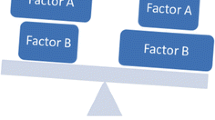Abstract
This paper proposes a model ofratio decidendi as a justification structure consisting of a series of reasoning steps, some of which relate abstract predicates to other abstract predicates and some of which relate abstract predicates to specific facts. This model satisfies an important set of characteristics ofratio decidendi identified from the jurisprudential literature. In particular, the model shows how the theory under which a case is decided controls its precedential effect. By contrast, a purely exemplar-based model ofratio decidendi fails to account for the dependency of precedential effect on the theory of decision.
Similar content being viewed by others
References
Aha, D. 1990. A Study of Instance-Based Algorithms for Supervised Learning Tasks. PhD thesis, University of California at Irvine.
Amarel, S. 1968. On Representations of Problems of Reasoning About Actions. InMachine Intelligence, ed. D. Michie, 131–171. Edinburgh University Press.
Ashley, K. D. 1990.Modelling Legal Argument: Reasoning with Cases and Hypotheticals. Cambridge MA: MIT Press.
Ashley, K. D. & Rissland, E. 1988. Waiting on Weighting: A Symbolic Least Commitment Approach. In Proceedings ofAAAI-88, Minneapolis. American Association for Artificial Intelligence.
Bareiss, R., ed. 1991. Proceedings ofThe Third DARPA Case-Based Reasoning Workshop. Morgan Kaufmann.
Barr, A. & Feigenbaum, E. A. 1982.The Handbook of Artificial Intelligence, volume 1. William Kaufmann.
Bellairs, K. 1989. Contextual Relevance in Analogical Reasoning: A Model of Legal Argument. PhD thesis, University of Minnesota.
Berman, D. 1991. Developer's Choice in the Legal Domain: The Sisyphean Journey with CBR or Down Hill with Rules. InThird International Conference on Artificial Intelligence and Law, pp. 307–309, Oxford: ACM Press.
Berman, D. & Hafner, C. 1993. Representing Teleological Structure in Case-Based Legal Reasoning: The Missing Link. In Proceedings ofThe Fourth International Conference on Artificial Intelligence and Law, pp. 50–59, Amsterdam: ACM Press.
Bodenheimer, E. 1974.Jurisprudence. Cambridge, MA: Harvard University Press.
Branting, L. K. 1991a. Integrating Rules and Precedents for Classification and Explanation: Automating Legal Analysis. PhD thesis, University of Texas at Austin.
Branting, L. K. 1991b. Reasoning with Portions of Precedents. In Proceedings ofThe Third International Conference on Artificial Intelligence and Law, pp. 145–154, Oxford: ACM Press.
Branting, L. K. & Porter, B. W. 1991. Rules and Precedents as Complementary Warrants. In Proceedings ofNinth National Conference on Artificial Intelligence, Anaheim: AAAI Press/MIT Press.
Cardozo, B. 1921.The Nature of the Judicial Process. New Haven: Yale University Press.
Clark, P. 1988. A comparison of exemplar-Based and Rule-Based Learning Systems. In Proceedings ofThe International Workshop on Machine Learning, Meta-Reasoning and Logic, Portugal.
Collier, C. W. 1988. Precedent and Legal Authority: A Critical History.Wisconsin Law Review 1988: 771–825.
Cross, R. 1979.Precedent in English Law. Oxford: Oxford University Press, third edition.
Cueto-Rua, J. C. 1981.Judicial Methods of Interpretation of the Law. The Publications Institute, Paul M. Hebert Law Centre, Louisiana State University.
Gardner, A. 1987.An Artificial Intelligence Approach to Legal Reasoning. Cambridge, MA: Bradford Books/MIT Press.
Gardner, H. 1985.The Mind's New Science. New York: Basic Books Inc.
Gentner, D. 1989. The Mechanisms of Analogical Learning. InSimilarity and Analogical Reasoning, ed. Vosniadu, S. & Ortony, A. London: Cambridge University Press.
Goodhart, A. 1930. Determining theRatio Decidendi of a Case.Yale Law Review 40: 161.
Holyoak, K. & Thagard, P. 1989. Analogical Mapping by Constraint Satisfaction.Cognitive Science 13(3).
Lakoff, G. 1987.Women, Fire, and Dangerous Things. Chicago and London: University of Chicago Press.
Larsen, A. 1989.The Law of Workmen's Compensation. volume 1. New York: Matthew Bender.
Levi, E. H. 1949.An Introduction to Legal Reasoning. Chicago: University of Chicago Press.
McCarty, L. T. 1989. A Language for Legal Discourse 1. Basic Features. In Proceedings ofThe Second International Conference on Artificial Intelligence and Law, Vancouver, B. C.: ACM Press.
McCarty, L. T. 1991. Invited Address, Third International Conference on Artificial Intelligence and Law, June 28, Oxford: ACM Press.
McCarty, L. T. & Sridharan, N. S. 1982. A Computational Theory of Legal Argument. Technical Report LRP-TR-13, Laboratory for Computer Science Research, Rutgers University.
Mooney, R. 1988. A General Explanation-Based Learning Mechanism and its Application to Narrative Understanding. PhD thesis, University of Illinois.
Morgan, E. M. 1948.Introduction to the Study of Law. Chicago, second edition.
Murphy, G. L. & Medin, D. L. 1985. The Role of Theories in Conceptual Coherence.Psychological Review 92: 289–316,299.
Murray, J. L. 1982. The Role of Analogy in Legal Reasoning.UCLA Law Review 29: 833–871,852.
Newell, A. 1982. The Knowledge Level.Artificial Intelligence 18: 87–127.
Oliphant, H. 1928. A Return to Stare Decisis.American Bar Association Journal 14.
Pople, H. E. 1973. On the Mechanization of Abductive Logic. InInternational Joint Conference on Artificial Intelligence, pp. 147–152.
Porter, B. W., Bareiss, E. R., & Holte, R. C. 1990. Concept Learning and Heuristic Classification in Weak-Theory Domains.Artificial Intelligence 45(1–2).
Raz, J. 1979.The Authority of Law. Oxford: Clarendon Press.
Rissland, E. L. 1990. Artificial Intelligence and Law: Stepping Stones to a Model of Legal Reasoning.Yale Law Review 99: 1957–1981.
Salmond, J. 1900. The Theory of Judicial Precedent.L.Q. Rev. 16.
Schauer, F. 1987. Precedent.Stanford Law Review 39: 571.
Skalak, D. & Rissland, E. 1992. Arguments and Cases: An Inevitable Intertwining.Law and Artificial Intelligence 1(1).
Toulmin, S. E. 1958.The Uses of Argument. Cambridge University Pres.
Tyree, A 1989.Expert Systems in Law. Prentice Hall.
Walker, R. 1992. An Expert System Architecture for Heterogeneous Domains. PhD thesis, Vrije University.
Wambaugh, E. 1894.The Study of Cases. Second edition.
Warner, R. 1989. Three theories of Legal Reasoning.Southern California Law Review 62(5).
Winston, P. H. 1980. Learning and Reasoning by Analogy.Communications of the ACM 23(12).
Author information
Authors and Affiliations
Rights and permissions
About this article
Cite this article
Branting, L.K. A computational model of ratio decidendi. Artif Intell Law 2, 1–31 (1993). https://doi.org/10.1007/BF00871744
Issue Date:
DOI: https://doi.org/10.1007/BF00871744




